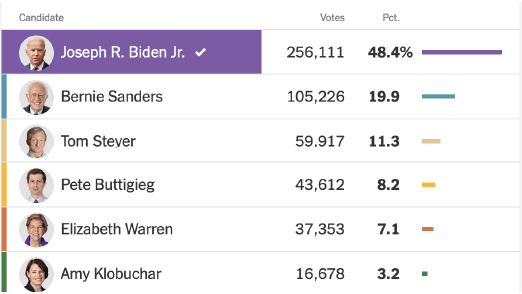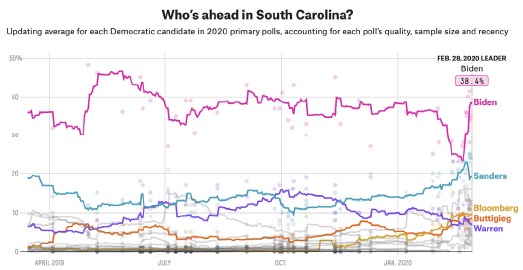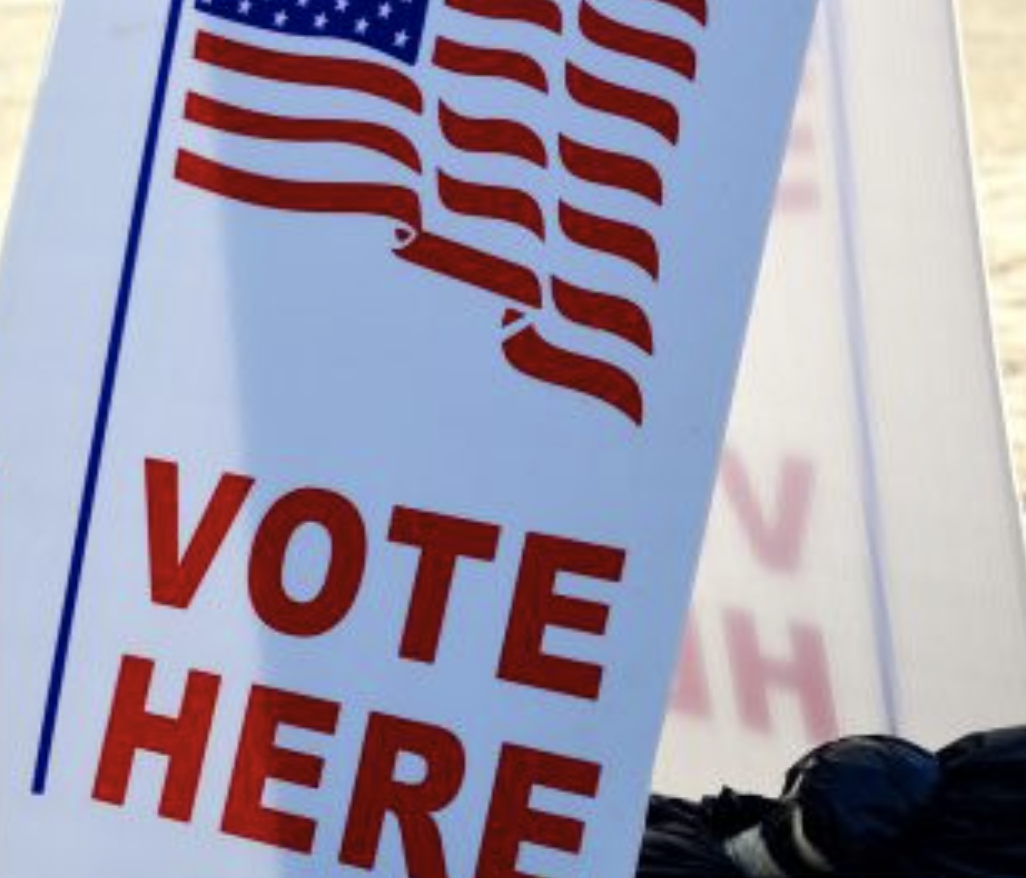After notching a second place finish in Nevada, Joe Biden made a dominant showing in South Carolina, taking home nearly half of all votes cast and beating the runner-up by a 28.5 percent margin. Biden did particularly well in South Carolina and his strong finish on Saturday has opened the door for him to perform well in the March 3rd Super Tuesday contests.
Results published by the New York Times show that Biden won 48.4 percent of the vote among South Carolinians, with Sanders in a distant second with 19.9 percent, Tom Steyer at 11.3, Pete Buttigieg with 8.2, Elizabeth Warren at 7.1, and Amy Klobuchar at 3.1 percent. In the lead up to election day, the RCP polling average had Biden at 39.7 Sanders at 24.3, suggesting that Biden had a roughly 14-15 point lead over Sanders.

Biden’s margin of victory turned out to be almost twice as big as his polls had previously suggested. To an extent, this runs in line with previous trends in South Carolina where the candidate winning the black vote tends to overperform substantially relative to their polls. In 2008, Barack Obama won in South Carolina by 28.9 points after having led in the polls by only 11.6 percent; in 2016, Hillary Clinton ended up winning the state by 47.5 percent of the vote after leading in the polls by 27.5 percent. With this context, Biden’s overperformance relative to his lead in the polls does not look too out of place.
However, there were some indicators of this movement among voters prior to election day. The FiveThirtyEight polling average showed a fairly dramatic shift – from 30% to 38.4% toward Biden – following in the final four days before the primary, while Sanders fell to 19% (and ended up winning 19.9% of the vote). This may be attributed to a well-received debate performance by Biden, as well as earning the endorsement of Congressman James Clyburn the day following the debate. According to the South Carolina exit poll, 61 percent of voters said Clyburn’s endorsement was an important factor in their decision, and 27 percent even said it was the most important factor in their decision.

In terms of how different groups broke out on election night, we have a clear picture that Joe Biden drew strong support from black voters (61 percent) as well as a majority of those whose top issue in the election is race relations. Biden received a plurality of support from voters age 30-44 and majorities of voters age 45-64 and those over the age of 65. Perhaps contrary to the expectation that most primary voters choose between liberal and moderate lanes when voting, Biden won 42 percent of voters who identify as very liberal or somewhat liberal, while also winning 54 percent of those identifying as moderate or conservative.

Sanders still did best among young voters (43 percent) and the very liberal (29 percent), but Biden’s dominant showing on Saturday makes clear that South Carolina was an especially good state for his campaign. And while the outcome here does not ensure that other southern states will vote in kind, the results from the first four primaries in aggregate suggest that diverse southern states like Texas, North Carolina, and Virginia could be extremely competitive between Biden and Sanders.
Not long after the race got called on Saturday, billionaire Tom Steyer ended his presidential bid. Falling short of expectations, Steyer won just 11.3 percent of votes and was unable to meet the 15 percent threshold required to receive pledged delegates, either statewide or in any individual Congressional District.1
Despite spending an estimated $150 million on TV ads and $253 million total since launching his campaign, Steyer undershot his polls by around 3-4 points and never rose above single digits in national polls.
On Sunday evening, the former South Bend, Indiana, mayor Pete Buttigieg also announced that he is dropping out of the presidential race, bringing the field down to six candidates post-South Carolina. Buttigieg ran what many considered to be a long-shot campaign, but went on to win in Iowa and placed second in New Hampshire to Sanders. In both Nevada and South Carolina, however, Buttigieg did not perform well, particularly among nonwhite voters. He won 11 percent of Latino voters and 2 percent of black voters in Nevada and he won 3 percent of black voters in South Carolina. Although Buttigieg was unable to expand his support beyond the first two states, he was also the most successful openly gay candidate in presidential primary history.
Similar to Buttigieg, Warren and Klobuchar each had significant
struggles winning over black voters, according to exit poll data. Even when adding these candidates’ vote shares together, their total percentage of support from black voters fails to crack 10 percent. Both Warren and Klobuchar did slightly better among white voters than black voters. But it seems that their efforts to win over black support were ineffective.

1. South Carolina awards 54 delegates total. 19 are allocated based on the statewide vote, 35 are divided between the state’s seven congressional districts. Candidates must receive 15 percent statewide or in a congressional district to win delegates. Similar rules apply in Super Tuesday states, where most delegates will be allocated based on the hundreds of congressional districts at stake, in which candidates must get at least 15 percent of the vote. This requirement could prove to be make-or-break for candidates on March 3rd.
In terms of how South Carolina will affect the race going forward, the odds have improved for Biden going into the next round of contests. The FiveThirtyEight model projects that Biden has a 13 percent chance to win a majority of delegates, up from 8.7 percent a week ago. Additionally, a new round of polls are showing that Biden has taken the lead in most southern Super Tuesday states, and polling from Virginia and Texas indicate both will be close races. Based on Biden’s performance in South Carolina and recent endorsements that high profile figures like former governor Terry McAuliffe, and Senator Tim Kaine, Virginia will be a contest where Biden may overperform the models.

Bernie Sanders remains the most likely candidate in the field to lead the pledged delegate count by the time of the convention and Biden winning a delegate majority remains far less likely at this point. In terms of projections, it’s still more likely than not that no one will win a majority of pledged delegates (65 percent per FiveThirtyEight). Sanders has maintained a double-digit lead in California, which is the largest single delegate prize (416). And while California may be slow to report its results, that contest could net a lot of delegates for Sanders particularly if Biden is not viable in some Congressional Districts across the state.
Since South Carolina, Sanders’ chances of winning the nomination outright have diminished but remain relatively high at 22 percent. In order for Biden to outpace Sanders, he will likely need a combination of sustained positive media coverage, consolidation of high profile Democratic elected officials’ endorsements, and tactical voting behavior among those who have yet to participate in their state’s primary or caucusing event. Regardless of how the delegate math works out, the remaining candidates will have a lot of work to do between now and July.
About Navigator
In a world where the news cycle is the length of a tweet, our leaders often lack the real-time public-sentiment analysis to shape the best approaches to talking about the issues that matter the most. Navigator is designed to act as a consistent, flexible, responsive tool to inform policy debates by conducting research and reliable guidance to inform allies, elected leaders, and the press. Navigator is a project led by pollsters from Global Strategy Group and GBA Strategies along with an advisory committee, including: Andrea Purse, progressive strategist; Arkadi Gerney, The Hub Project; Christina Reynolds, EMILY’s List; Delvone Michael, Working Families; Felicia Wong, Roosevelt Institute; Mike Podhorzer, AFL-CIO; Jesse Ferguson, progressive strategist; Melanie Roussell Newman, Planned Parenthood Federation of America; Navin Nayak, Center for American Progress Action Fund; and Stephanie Valencia, Latino Victory Project.
For press inquiries contact:
press@navigatorresearch.org
Featured polls
[featured_polls]

